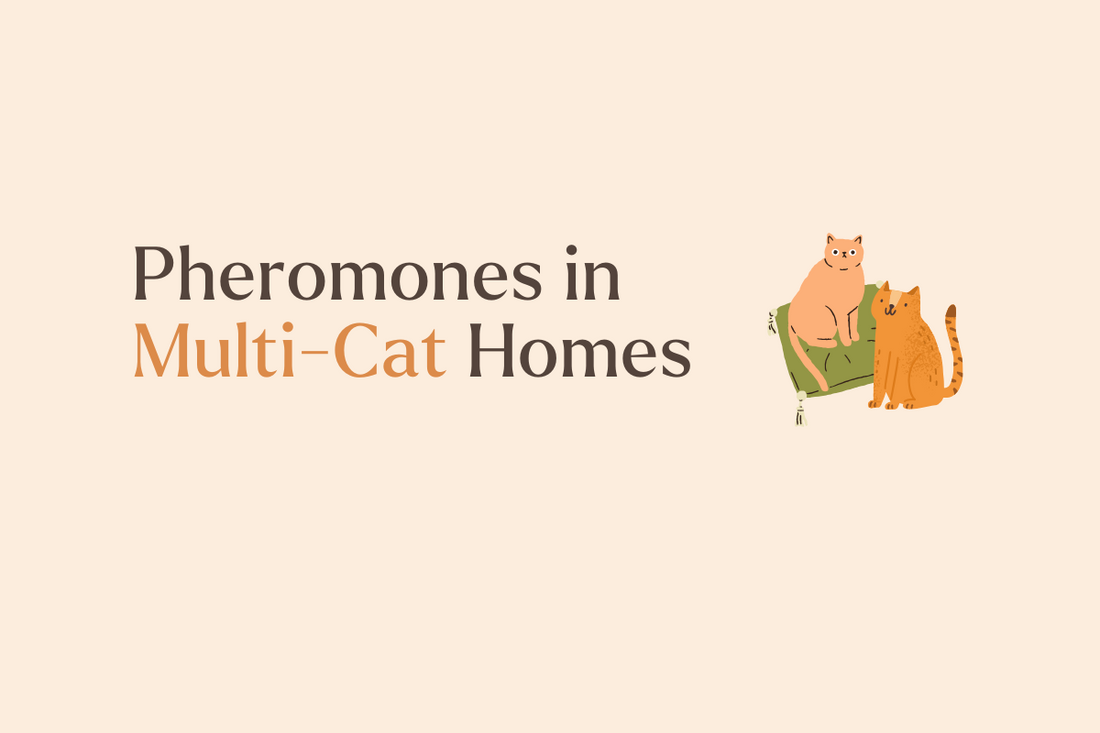
Fighting or Friends? How Pheromones Ease Multi-Cat Household Tension
Living with more than one cat can be a dream, or a total disaster. One minute they’re sleeping side by side like angels. The next, someone’s growling, chasing, or hiding under the bed for hours.
If you’ve got drama in your multi-cat household, you’re not alone. Social tension is one of the top reasons cats are surrendered to shelters. But there’s good news: science has given us a surprising tool to help cats get along better, pheromones.
Let’s take a look at how pheromones work in multi-cat homes, what the research says, and how to actually use them without wasting your money.
What’s Going On Between Your Cats?
Most cats don’t fight “just because.” There’s usually something causing the stress, territory issues, competition for food or litter boxes, or even the introduction of a new pet or baby. And since cats aren’t big on direct confrontation, you might see more subtle signs of tension before a full-blown fight:
-
One cat blocks the hallway so the other can’t pass
-
You notice more hiding, or one cat always eats last
-
There's hissing, growling, or tail flicking
-
Grooming turns into biting or chasing
This isn’t just about “being moody.” Long-term tension affects your cats’ physical and emotional health, and yours too.
What Are Cat Appeasing Pheromones?
When a mother cat is nursing her kittens, she releases calming chemicals from glands near her mammary area. These cat appeasing pheromones (CAPs) help kittens feel safe, secure, and bonded.
Synthetic versions of these pheromones have been developed and used in diffusers like Feliway Friends or Zenifel MultiCat. They’re designed to mimic those natural maternal signals and tell adult cats, “Hey, it’s okay. You’re safe here.”
Unlike sedatives or meds, pheromones don’t change your cat’s personality. They just turn down the volume on the tension, so social interactions aren’t so intense.
The Science Behind It
A few key studies have looked at whether these products actually work, and the results are promising.
In a 2018 pilot study of 45 multi-cat homes, families used either a CAP diffuser or a placebo for four weeks. The homes using the pheromone saw significantly reduced aggression, chasing, and staring compared to the placebo group. One of the most helpful tools was something called the OFSIS-Aggression scale, which tracked daily tension behaviors like hissing and swatting. By the end of the trial, households using pheromones had better scores and calmer cats.
Another study in 2021 looked at Feliway Optimum, a blend of multiple synthetic pheromones, and found that it helped reduce both conflict and avoidance behaviors in multi-cat homes within the first two weeks of use.
While not every cat responds, many do, and there’s no harm in trying since these products are safe and easy to use.
Real-World Use: How to Set It Up
Here’s how to actually use pheromones effectively in your home:
-
Plug in the diffuser in the room where your cats hang out most (not behind furniture)
-
Leave it on 24/7 and change the refill every 30 days
-
Use one diffuser per 700 square feet (if you’ve got a bigger space, use two)
You might start seeing changes within a week, but full results often take 2–4 weeks.
And remember: don’t expect miracles. Pheromones work best alongside good multi-cat household practices like:
-
One litter box per cat, plus one extra
-
Separate food and water bowls
-
Vertical spaces (like cat trees or window shelves)
-
Daily play sessions to burn off extra energy
What It Looks Like When It Works
Here’s what other cat parents have noticed after using pheromones:
-
Cats who used to avoid each other start hanging out again
-
Less growling and more peaceful coexisting
-
Better tolerance during feeding times
-
Reduced chasing and territorial behavior
Of course, you might still see the occasional spat, cats are cats, but the overall vibe of the home shifts from “tense” to “tolerable” and often even “friendly.”
If your cats act like sworn enemies or simply can't seem to share space without drama, pheromones might be the quiet fix you've been looking for. They don’t sedate, they don’t discipline, they just tap into your cat’s natural sense of safety and security.
Used right, pheromones can help turn “ugh, not again” into “hey, look at them sharing the couch.”
And that? That’s a win.
Written by Milind Patel
Designed by Lexin Yuan
References:
DePorter, T. et al. (2018). Pilot Study on Feliway Friends for Multi-Cat Aggression. JFMS
De Jaeger, X. et al. (2021). Evaluation of a New Pheromone Complex in Cats. Open Journal of Veterinary Medicine
Crump, E. (2023). Feline Facial Pheromones in Clinic Settings. Veterinary Eviden
